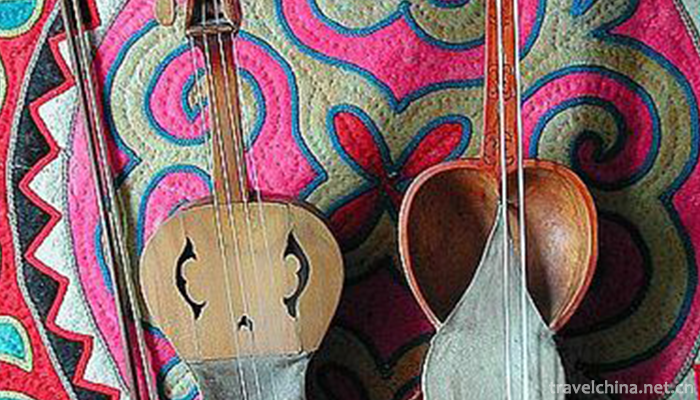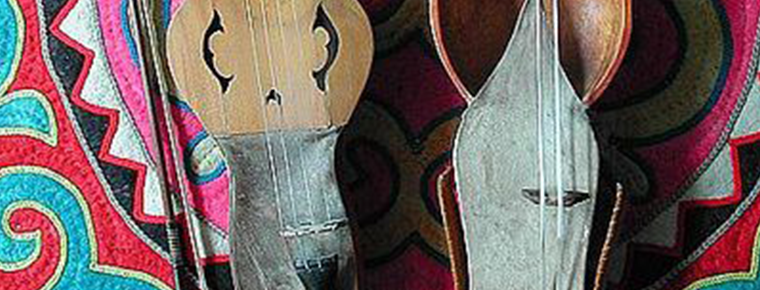Kazakh Kubuzi
Kazakh Kubuzi
Kubuzi is the representative of Kazakh's playing instruments. Chinese is also translated into Hobbes, Hobbes, Kibbs and so on. Kubuzi structure is simple and beautiful, used for solo, ensemble or accompaniment, popular in Xinjiang Uygur Autonomous Region Yili Kazakh Autonomous Prefecture, Barikun, Muli Kazakh Autonomous County, Haixi Mongolian Tibetan Kazakh Autonomous Prefecture in Qinghai Province and Aksai Kazakh Autonomous County in Gansu Province.
On May 23, 2011, Kazakh Kubuzi was listed in the third batch of national intangible cultural heritage list with the approval of the State Council.
historical origin
According to folklore, Kubuzi was closely related to Religion in ancient times. It was a necessary instrument for people to divine and cure diseases by Kazakh witches. Wizards occupy a very important position in Kazakhs, but they are not omnipotent, but are dominated by gods. In the process of inviting gods, the wizard should first play the music that the gods love to listen to with Kubuzi, so that the gods can go down and attach themselves to the wizard, and answer all kinds of divination through the wizard's mouth. Kubuzi has become a tool for communication between wizards and gods. The higher the wizard's skill of playing Kubuzi, the more melodious the melody, the earlier the gods appear. Kubuzi has become a skill that wizards must learn well. Whenever Kazakh festivals or festivals are held, wizards play folk music, which is also an instrument for mass entertainment.
Although the historical documents do not contain the time when it came into being, it can be inferred that Kubuzi has a long history from the ancient Kazakh people living in good neighborhood with Mongolian and Kirgiz people, and from the similarity and close origin between Kubuzi and Mongolian stringed instruments, such as Tofuxiu and Kirgiz La stringed instruments.
The earliest Kubuzi, also known as Klekubuzi, is one of the oldest stringed instruments circulated among the Kazakh people. Its body is bowed, with only one horsetail string and no fingerboard at its neck. Because the herdsmen make the piano locally and according to their aptitude, the style and size of the piano are often very different. This most primitive stringed instrument can still be seen in remote mountainous areas of Kazakhstan. Later, on the basis of Klekubuzi, the two-stringed Klebzi was made by adding chord axis (left and right), strings and fingerboard. It still uses horsetail string or cow-tendon string, which is very similar to today's Kirgiz laconic instrument Kyak.
artistic characteristics
The traditional Kubuzi piano body is made of a whole piece of wood, 60 cm to 65 cm in length. The shape of the resonance box is spoon-shaped. The top part is large and the bottom part is small. The length of the box is 27 cm to 29 cm. The upper part is open-type exposed, without skin film or wooden panel, and the lower part is covered with camel skin or sheep skin. The head of the piano has no ornaments, with chord grooves and chord pillows, and three chord axes (left one and right two) on both sides. The neck is slender and long with no taste on the front. A piano horse and three camel strings are arranged on the skin membrane.
In the Museum of Chinese Musical Instruments of the Music Research Institute of Beijing Academy of Art, there is a Kubuzi from Kazakh people on display. The body of the piano is made of a whole piece of mulberry wood with a total length of 63 cm. The abdominal cavity is dug out at the lower part of the timber. The upper part of the resonance box is semi-circular and the lower part is semi-cylindrical. The length of the piano box is 28.5 cm, the upper part is 15 cm wide, the lower part is 10 cm wide, the upper part is 8 cm thick and the lower part is 5.5 cm thick. The upper part is covered with sheepskin and the upper part is exposed. The piano head is semi-curved, with a rectangular chord groove in the middle and three axes (left one and right two) on both sides. Chord axle pear wood, for Violin button string type, axis length 6 cm. The leather is covered with wooden horses and three strings. The bow of a violin bow is made of wood and tied with a horsetail as its bow hair, similar to that of a violin bow.
Playing in a sitting position with legs flat and knees clamped at the bottom of the box; holding the piano in the left hand, using the fingertips of the index finger, middle finger and ring finger to the outside of the first joint, it is difficult to press the strings from inside to outside; holding the horse-tail bow and sticking rosin in the right hand to play outside the strings. The chord is g, a, d1, and the range g-g2 has two octaves. It sounds like a violin.
Representative works
Most of the performances are folk tunes, and the more famous ones are Altay and the Black Walker.
Inheritance significance
Every song in real folk traditional music contains a complete story or moral, and has its own unique melody. Because many ethnic minorities live in remote and obscure places, and their music crosses the border, penetrates the air, and connects with nature. It makes people feel that music is so real and natural. It is also true that real music is folk, traditional and world, and there is no boundary. Traditional Kubuzi's life should also be long-term, because the music it plays is like the scenery to the eyes, it should be an eternal landscape.


-
1.Baishuiyang Yuanyangxi Tourist Area
Baishuiyang Mandarin Creek is located in Pingnan County, Ningde City, Fujian Province. It is 170 kilometers away from Fuzhou and 101 kilometers away from Ningde
Time 2018-12-08 -
2.Hohhot Laoniuwan Tourist Area
Laoniu Bay is located at the entrance of Shanxi-Shaanxi Grand Canyon. This is the Great Wall, the only typical parallel section of the Yellow River. The widest part of the river is not more than 100 m
Time 2019-01-16 -
3.jianchuan museum cluster
Jianchuan Museum is called Jianchuan Museum Settlement in Chengdu City. Founded by private entrepreneur Fan Jianchuan, it is located in Anren Town, Dayi County, a small museum town of China
Time 2019-01-21 -
4.Cloth paste painting
Teng Teng is the founder of Teng's cloth paste painting. He was born in Fengning Manchu Autonomous County, Hebei Province in 1932. He is the director of Teng's cloth paste painting
Time 2019-04-04 -
5.Tibetan costume
Tibetan costumes Tibetan men's clothes are divided into three categories: labor dress, superfluous dress and warrior dress. Women's clothes change greatly in festivals, major events in life and etique
Time 2019-04-05 -
6.Iron flower
Tiehua is a kind of fireworks which spread in the folk traditions of Henan and Jin Dynasties. It has a long history which can be traced back to the Spring and Autumn Period and the Warring States Peri
Time 2019-04-23 -
7.Weaving and Dyeing Techniques of Felt and Printed Fabric
Uygur felt, printing and dyeing technology, Xinjiang Uygur Autonomous Region Turpan (now Turpan) local traditional skills, one of the national intangible cultural heritage.
Time 2019-05-04 -
8.Herbal tea
Herbal tea is the general name of traditional Chinese herbal medicinal plant beverage. Guangdong herbal tea is the representative of traditional Chinese herbal tea culture. Herbal tea is a kind of bev
Time 2019-05-13 -
9.Miao Batik Dyeing Techniques
Batik dyeing is one of the ancient folk traditional printing and dyeing techniques of the Chinese nation. As early as the Qin and Han Dynasties, the Miao people had mastered batik dyeing techniques, a
Time 2019-06-05 -
10.Golden Gong dance of Yao nationality
In November 2014, the Golden Gong dance of Yao nationality declared by Tiandong County of Guangxi Zhuang Autonomous Region was listed in the fourth batch of national intangible cultural heritage list
Time 2019-07-11 -
11.Environmental protection in Mianyang
In 2018, the water quality of Fujiang, Kaijiang, Zijiang, Anchang River, Furong River, Tongkou River and Luban reservoir in Mianyang City accounted for 100% of the total water quality. Among them, Fujiang River, Tongkou River, Zijiang River and Anchang
Time 2020-12-14 -
12.Administrative division of GuanganTime 2020-12-19